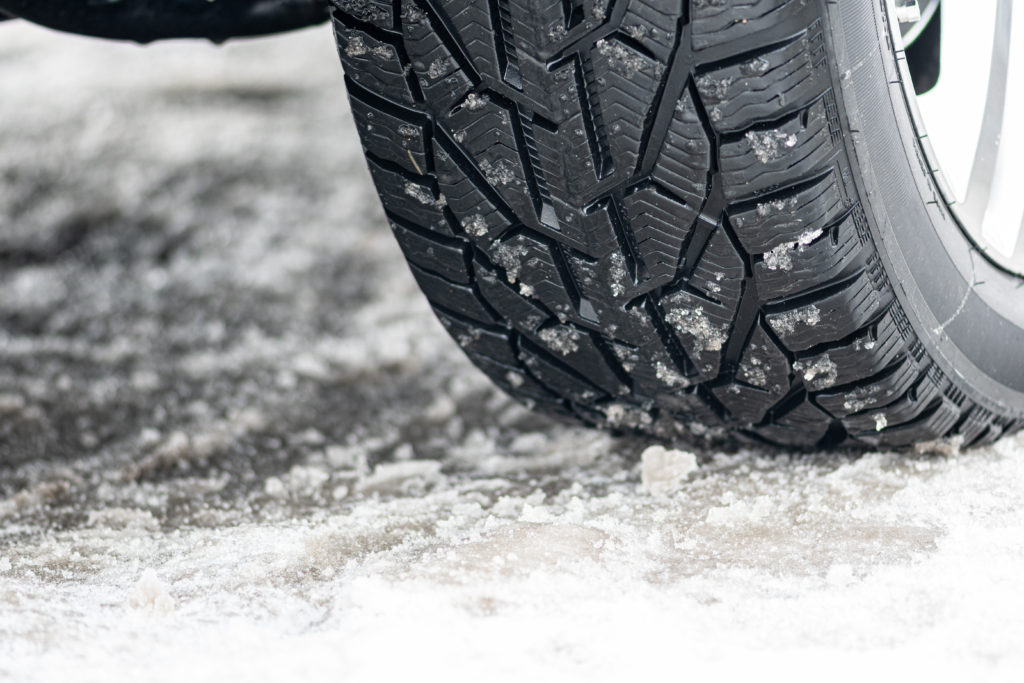01 Dec How to Drive Safely in Snow & Ice
One of the most dangerous driving conditions a person can face is when driving on roads affected by winter weather. As a personal injury law firm, we’ve seen firsthand the effects winter weather can affect a person’s life. Whether someone slips and falls on ice or gets in a car accident from black ice or snow on the road, the injuries can be devastating and long lasting.
The scariest part about driving in ice is that it is so unexpected, meaning even if you are a safe and defensive driver you could easily fall victim to the slippery roads. However, there are some steps you can take to make you better equipped to handle the icy roads. Here’s how you can drive safe in snow and ice to prevent injury for yourself or someone else.

Preparing Your Vehicle Ahead of Time
Prepare your car in advance for winter. Make sure your vehicle’s maintenance is up to date. You especially want to keep an eye on your battery; no one wants a dead battery in the freezing cold. You always want to check your wipers and wiper fluid to make sure your windshield stays clear of road salt and dirt.
Check your tires to make sure they are properly inflated, and the tread depth is acceptable. If you’re planning on using snow tires, you want to get them installed before the snow begins to fall.
Before you head out on an unusually snowy day, remember to clean off your vehicle’s roof. Not only is flying snow from your car a distraction to you and other drivers, but failure to remove snow and ice on your vehicle could result in a hefty fine in the state of New York.
Check the Weather
By checking the winter road conditions before heading out, you’ll have an idea of what you’ll be facing on the roads. Remember, your vehicle handles each road condition differently; even with four-wheel or all-wheel drive, icy roads are still dangerous!
Ultimately, if there is dangerous winter weather approaching, try to avoid the roads as much as possible. Sometimes this is not an option, but if it is possible, it would be best to avoid the roads altogether.
Leave Early and Drive Slowly
If you are going to be driving in the snow and ice, give yourself plenty of time to get to your destination. Most of the time, driving accidents where the driver loses control can be prevented if the driver slowed down and increased the braking distance.
Avoid Distractions
Distracted driving has been steadily increasing over the past decade. In 2016 alone, 3,450 people lost their lives in distracted driving accidents. 391,000 people were injured in distracted driving accidents in 2015. It’s a severe problem in the best of road conditions – throw snow into the mix, and you have a recipe for disaster.
Learn how to Counteract Skids
When you face ice or snow on the road, your tires can easily skid due to the lack of friction. This is what often causes accidents, because the driver loses control and the brakes don’t work as they should. We have a more in depth blog on how to get out of a skid found here.
To summarize, here are 5 types of skids and how to get out of them:
WHEEL SPIN
If your wheels start spinning but you’re not moving, take your foot off the accelerator, and retry accelerating with a much lighter foot. Slowly and cautiously accelerate until your tires regain traction. You might have to give this a couple of tries if your wheels are stuck in snow. Driving slow on the road reduces your chances of having a wheel spin.
WHEEL LOCKUP
If your car is still moving while your wheels are braking, pulsate your brakes. Release them and softly/progressively brake again until you feel your wheels turn with your steering wheel toward a safe zone. Repeat this rapidly over and again until you come to a full stop in a safe area. To avoid this from happening, increase your braking distance and brake slowly.
UNDERSTEERING
An understeer skid is when you aren’t able to turn enough around a corner. Don’t turn your wheels further in that direction, this will not help. It will likely make it worse. Your best bet is to try to regain traction. Jerking your wheels straight and then slowly turning them in the direction you want to go can help your wheels gain traction so you avoid skidding off the road.
OVERSTEERING
The “Oversteer Skid” happens when your rear tires lose traction on the road and propels your car into a slide, usually caused by a wheel spin in rear-wheel drive vehicles. The solution to an Oversteer Skid depends on whether you’re driving a rear-wheel drive car or a front-wheel drive car. If you’re driving a rear-wheel drive car, your first step should be to take your foot off the gas. If you’re driving a front-wheel drive car, take your foot off the brakes and gently apply gas. Then, slightly steer into a safe direction. If you jerk your steering wheel too quickly, you won’t gain any traction and thus continue to keep skidding. Progressively turning will help your wheels gain traction. To avoid this, try to slow down before approaching a turn.
FISHTAILING
If your car is skidding back and forth like a pendulum, you’re fishtailing. If you’re in a car with rear-wheel drive, your first step is to take your foot off the gas. If you’re in a car with front-wheel drive, take your foot off the brakes and gently accelerate. With each swing, slightly turn your wheel toward the direction you want to go. Again, if you turn your wheel too far, you won’t gain traction and you’ll continue to skid. So, remain calm, and continue to slightly turn your wheel in the direction your rear-end is fishtailing toward (likely the direction you were heading) until you gain complete traction back and can recover your trajectory.

About the Author
Steven Palermo is the managing partner for Palermo Law, Long Island’s Personal Injury Law Firm. He has been helping people receive compensation for their injuries for over 21 years. He focuses on cases involving car accidents, truck accidents, construction accidents and slip and fall injuries.
His book The Ultimate Guide to Handling New York Car Accident Claims details the ins and outs of a car accident claim in a simple, easy-to-read manner.

